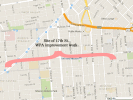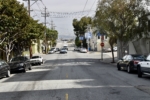17th St. Improvements – San Francisco CA

The federal Works Progress Administration (WPA) worked to improve many roads in San Francisco, including the stretch of 17th Street between Market and Harrison.

The federal Works Progress Administration (WPA) worked to improve many roads in San Francisco, including the stretch of 17th Street between Market and Harrison.

The Works Progress Administration (WPA) improved many roads in San Francisco, California, including widening a 1,655 foot stretch of 18th Street between 3rd and Missouri Streets (between Potrero Point and the crest of Potrero Hill).

The federal Works Progress Administration (WPA) worked to improve many roads in San Francisco, including the stretch of 25th Ave. between Fulton St. and El Camino del Mar.

The federal Works Progress Administration (WPA) worked to improve many roads in San Francisco, including the stretch of 3rd St. between what was then Bayshore Blvd. and Burke Ave. Highway 101 now occupies that stretch of Bayshore Blvd.

Academic unit; shop unit, 2 gyms, auditorium to be added later. 1 new building. The October 3, 1938 edition of the Daily Pacific Builder reported that $750,000 in PWA funds had been allotted for the first unit of the construction… read more

Now the Ellis-Polk Police Station. Remodeled room for telatype and general complaints.–Healy, p.72. Originally the Adams School Annex, this building was then the San Francisco Ellis-Polk or "Northern" Police Station for many years. Though the inscription above the door now… read more

Vocational night school. Eighteen classrooms. Near high school. ‘Bids will be opened […] for constructing Agassiz elementary unit of twelve classrooms to be located at Bartlett and Twenty-second Streets. Masten and Hurd are the architects. The estimated cost is $179,000.’–The Architect… read more

The Public Works Administration funded improvement work at the Alcatraz Prison on Alcatraz Island. The cost of the project was $1,100,000. The funds for the modernization were earmarked through a PWA program in 1938. The modernization plans were temporarily suspended after the… read more

This frieze on the ceilings of the library’s reading rooms depicts “Flowers and Animals” and was funded by the FAP and WPA. The artist is currently unknown to the Living New Deal. The library itself was completed in 1932, but is… read more

The federal Works Progress Administration (WPA) worked to develop Aptos Playground in San Francisco during the Great Depression.

Richard Ayer’s bas relief “Nautical Abstractions” is composed of paint on plaster with embedded rope and piping. It is located on the 3rd floor of the Aquatic Park in San Francisco. Ayer also painted the mural “Tugboats” installed on the… read more

Beniamino Bufano’s brown granite sculptures of, respectively, a seal and a frog were completed in 1942 with the help of FAP funds. They are available for view on the bayside exterior porch.

This oil-on-plaster “Prismatarium” mural was designed by Hilaire Hilel to give “striking demonstrations on the relationship of color and light.” It covers the walls and ceiling of a circular room on the west side of the building. Originally, the light… read more

This 14′ x 125′ glazed tile “Sea Forms” mural was created by Sargent Johnson in 1939 with the help of FAP funds. The east end is incomplete because of artist protests over plans for a private restaurant on the site…. read more

Sargent Johnson’s 30′ x 14′ “Sea Form Marquee” frieze of incised green slate at the Aquatic Park in San Francisco was completed in 1939 with FAP funds. Johnson also created a 3′ x 5′ ceramic lintel bas relief on the 4th… read more

The Blue Room is one of the original dining areas in the WPA Aquatic Park Bathhouse building, within the Aquatic Park NHL District. Original drawings refer to this circular room on the eastern side of the second level as “restaurant.”… read more

The WPA built these concrete steps connecting Aztec and Shotwell Streets in 1940.

(100 Acres) Constructed gutters, paths, seepage pits, culverts, storm water inlets, etc. This work completed previously built park roads.–Healy, p. 55. Most of the rock for gutters is to be quarried on the property.–Mooser, p. 82.

The federal Works Progress Administration (WPA) worked to improve many roads in San Francisco, including the 1.8-mile stretch of Bay Street between Fillmore St. and The Embarcadero.

Landscaped embankment along Bay Street. Built small recreation building.–Healy, p. 67.

The Beach Chalet at the western end of Golden Gate Park, built in 1925, is home to a trove of New Deal artworks in the first floor lobby, or entrance hall. The centerpiece of the Beach Chalet’s artworks is an… read more

The Beach Chalet at the western end of Golden Gate Park in San Francisco contains several New Deal artworks. Lucian Labaudt painted a set of monochrome frescoes around the stairwell and in the corridor to the restrooms on the south… read more

The Beach Chalet contains several New Deal artworks. Include decorative mosaics by Primo Caredio, done in 1937. They are located in the South Staircase and over the north and east doorways of the large first-floor lobby. All the Beach Chalet… read more

Michael von Meyer created the enameled, magnolia wood carvings, called “Sea Creatures,” in the balustrade of the south stairway of the Beach Chalet. The carvings are 36″ high and run all the way up to the second floor, about 25… read more

“The San Francisco Belt Railroad was a short-line railroad along the Embarcadero in San Francisco, California. It began as the State Belt Railroad in 1889, and was renamed when the city bought the Port of San Francisco in 1969. The… read more

Cost $255,547, for Alabama to Esmeralda Streets. Work consisted of building 1,890 lineal feet of sewer with catch basins and manholes, 12,890, lineal feet of redwood curb, 19,050 square feet of 6 inch concrete pavement. Placed 714 tons of 2… read more

The beautiful Bernal Heights Library on Cortland Avenue in San Francisco was built in 1940 by the Works Projects Administration (WPA), after it had become part of the Federal Works Administration (FWA) in 1939. The library is built of reinforced… read more

The Works Progress Administration (WPA) built the Bernal Recreation Center in San Francisco in 1939-1940. It sits just behind and below the Bernal Heights Public Library. Work consisted of excavating and grading 1,492 cubic yards of rock and soil, building… read more

Made general repairs, cleaned tile and installed new tile, replaced glass, installed new plumbing and heating fixtures, did painting and concrete work, layed new floor in main auditorium, made accomodation for new health service municipal employees, increased corridor space on… read more

The federal Works Progress Administration (WPA) worked to improve many roads in San Francisco, including the 1.6-mile stretch of Brannan St. between The Embarcadero and 10th St.

The federal Works Progress Administration (WPA) worked to improve many roads in San Francisco, including the stretch of Broadway St. (then simply Broadway) between Mason St. and Davis St.

The federal Works Progress Administration (WPA) worked to improve many roads in San Francisco, including Brunswick St. “Consisted of excavation and disposal of 3,550 cubic yards of earth and rock, making available for use a hitherto ungraded street from Allison… read more

The Public Works Administration (PWA) funded construction of the Buena Vista Elementary School (now Bryant Elementary) in the 1930s. We believe that the New Deal building is still in place. A record card for the project in the National Archives… read more

'(36 Acres) Work done consisted of rocking 1,500 lineal feet of paths 8 feet wide, surfacing 132,960 square feet of foot paths, resurfacing 22,300 square feet of drives, laying 15, 455 lineal feet of rock gutters, building 6,000 square feet… read more

The federal Works Progress Administration (WPA) worked to improve many roads in San Francisco, including the stretch of Bush St. between Fillmore St. and Presidio Ave.